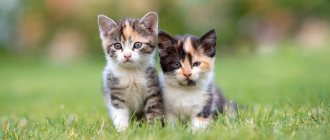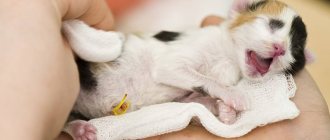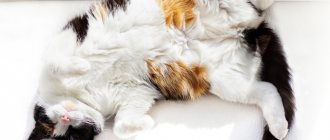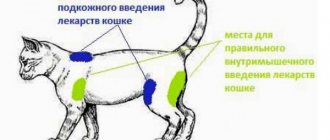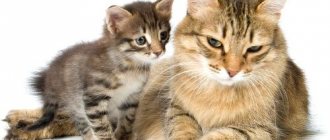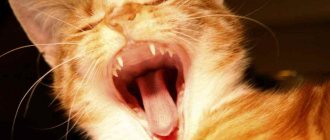( 1 votes, rating: 1.00 out of 5)
5589564
05/19/2021 owner reviews 1,
“What to expect? What is this? Why do kittens die? Yes. The search is not wrong. Kittens do die suddenly and yes, it is very sad.
It's just the circle of life. It's not easy for cats to survive in this world. From searching for food, water and shelter... staying alive was challenging to say the least. Harsh winters don't help either...you'll find that many unprepared cats won't be able to handle the cold.
However, not all of this is depressing! Life is meant to be a gift, and for those who can hunker down and survive, they can do what all other animals do in the springtime: gain experience!
The kittens you find at your local shelter or pet store tend to be lively and a little mischievous. However, before kittens can be accepted into these shelters and adoption centers, they must first be nursed to a certain age of maturity. Many foster parents who have struggled to raise these little kittens may be faced with a tragic problem. Unfortunately, many kittens under nine weeks of age eventually die due to fading kitten syndrome.
- So... What is Fading Kitten Syndrome?
- What Causes Fading Kitten Syndrome?
- Symptoms of Fading Kitten Syndrome
- What to do
Causes and timing of death of kittens
From seven to nine percent of purebred cats are born dead, or do not live longer than a week (they die). Another critical moment in development occurs at one month of age, when weaning from mother's milk, which gives immunity to infections. Non-viable cubs that die during breastfeeding are called “fading”.
What can kill a kitten - hypoglycemia, hypothermia, dehydration.
Sometimes the death of a newborn cat occurs unexpectedly. But most weakened babies develop symptoms of decline a few days before death: refusal of milk, restless behavior. At this stage, the baby can be helped by providing the necessary care and nutrition. The owner may not notice the dangerous signs in time, and then the process will become irreversible. The blood sugar level will decrease catastrophically, the frozen kitten will have a drop in body temperature (<34⁰C), pulse and breathing intensity will decrease until the heart rate completely stops and death.
Newborn kittens have eaten and sleep
First aid
In the absence of consciousness in an animal, it is necessary to ensure the supply of oxygen in the blood to the brain. To do this, lift your pet by its hind legs so that its head is down.
If the patient is small, you can try to spin him, this will increase the effect of centrifugal force on blood flow.
Place a large animal head down, raising its hind legs.
The return of consciousness is manifested by the reaction of the pupil to light and its constriction. In more complex cases, it is necessary to carry out manipulations to restore the vital functions of the body.
First you need to determine whether the animal is breathing or not. To feel breathing, bring your cheek to his muzzle, or bring a mirror to his mouth; if it fogs up, then there is breathing.
To increase air flow, open the animal's mouth and stick out its tongue. You can additionally open the windows to provide more fresh air in the room.
Next you should feel the pulse. You can determine the work of the heart by pressing your fingers to the femoral artery in the groin or to the carotid artery in the neck. If the pulse does not disappear, proceed to restore respiratory function using the mouth-to-nose method.
If it is absent, perform a heart massage along with ventilation. This will prevent vital functions from disappearing and will enable the body to continue the fight.
Hypoglycemia
Until the age of four weeks, the glycogen content in the kitten’s body is low. At this stage of life, muscle contractions, rather than the breakdown of glucose and brown fat, are responsible for heat production. Lack of glucose leads to hypoglycemia. A common cause is a large number of babies or insufficient milk from a nursing mother.
Glucose deficiency manifests itself:
- lethargy;
- passive behavior;
- convulsions;
- drop in body temperature.
At the initial stage, the baby can be saved by introducing additional complementary foods (natural milk substitute) and vitamins. If the disease is complicated, the veterinarian may prescribe an oral glucose solution. Injections under the skin at an early age are not recommended.
Hypothermia
The first weeks after birth, maternal warmth is vital for kittens, since the cubs’ own thermoregulation is far from perfect. Instinct dictates that mothers should not leave their furry babies alone for long periods of time. If the nest with babies is located in a cold place in the home, the cat can, on its own initiative, drag the offspring. The temperature in the room where babies grow should be maintained above 22 °C.
A kitten that finds itself far from the nest will have a gradual decrease in body temperature. The limit of 34 °C is a critical value at which the sucking reflex ceases to appear in a frostbitten kitten and digestive processes freeze. The mother will not care for such a child; without human help, the kitten will die. You can warm up your kitten using a heating pad and a warm blanket. Only after the animal’s temperature rises to 36 °C can you feed the baby formula using a pipette or bottle.
Attention! Giving food to a kitten (who is shivering) with a low temperature is dangerous. The milk will either enter the respiratory system or remain undigested inside the stomach. Both options will lead to immediate death.
Dehydration
Newborn animals must consume much more fluid than adults, as they rapidly lose moisture from the surface of the body. The average water consumption rate for a baby is 150 ml per kg of body weight, which is approximately twice as much as for an adult cat. Lack of milk or diarrhea leads to rapid development of dehydration. For these symptoms, your veterinarian will usually prescribe saline injections.
The air humidity in the room where the cubs grow must be at least 60%.
So... What is Fading Kitten Syndrome?
Fading kitten syndrome is not a disease, but rather refers to the unfortunate death of a kitten in the first weeks of its life. This essentially means that the kitten will not survive beyond infancy. There can be many reasons leading to a rapid deterioration in a kitten’s health. Without proper care or treatment, the kitten will eventually die.
This is not a contagious disease that can be transmitted to other cats and animals. However, if there is a kitten that has passed away due to Fading Kitten Syndrome, there may be a higher chance that other members of the litter will also become affected.
© shutterstock
Birth trauma and birth defects
Early mortality is often associated with oxygen starvation of the body due to delay in the birth canal or late opening of the fetal membrane. A female giving birth for the first time may need human assistance. This is especially important if labor is prolonged.
Experience shows that resuscitation of a newborn kitten without signs of life does not give positive results. Lack of oxygen immediately after birth has fatal consequences: serious damage to the nervous system and brain of the baby. It is also very difficult to resuscitate premature kittens.
Anomalies that cause death:
- cleft palate;
- absence of anus;
- navel hernia;
- cleft lip;
- skeletal deformity;
- disorders of blood supply and cardiovascular activity;
- respiratory system defects;
- absence of organs.
If the birth of children with serious pathologies recurs, the female should be sterilized.
You can bring a baby back to life in the following cases:
- the baby was born with low body weight;
- the baby’s cranial bones or ribs are deformed;
- one or more limbs are missing.
Making a decision about the need for resuscitation measures falls entirely on the shoulders of the animal owner. It should be taken into account that a cat with congenital defects will have reduced immunity.
In addition to these reasons, the death of a newborn may be a consequence of an infection transmitted in the womb of the mother.
Photo - British kittens after eating
Important Notes
Firstly, we note that the fact of the birth of a stillborn kitten (even if it is the first) does not mean something catastrophically dangerous. Cats are prolific animals, and therefore, after a dead cub, they may well be born alive and healthy. Moreover, experienced breeders probably know that a certain percentage of waste always occurs.
Alas, inexorable veterinary statistics accumulated by practicing specialists around the world indicate that in purebred animals the risk of giving birth to dead kittens is always higher (and significantly) than in outbred “murks”. This is especially true for Persians: in some cases, up to 7% of kittens are born dead in pets of this breed, and another 9% of cubs die within the first week of life.
In general, it is the Persians who collect the most sad statistics: it is believed that if 75% of kittens are alive by the third week of life, then this is a very good result. It often happens that more than half of all newborns die. This deplorable situation is associated with a huge number of genetically transmitted diseases. There are cases where a third of the entire litter was born with severe liver pathologies (including the complete absence of this organ).
Secondly, it is necessary to distinguish between cases of stillbirth and infant death . Remember that in situations where a kitten dies within the first hours after birth (or even the first days), it is also customary to talk about “stillbirth”.
Thirdly, it is necessary to distinguish between situations when kittens were born dead, being still in the womb, and cases when the cubs, initially healthy (at least partially), died directly during the birth process .
Main predisposing factors
We list the most common causes of stillbirth encountered in veterinary practice:
- Hypoxia (lack of oxygen). This is a very common pathology in cases of protracted labor, when the kitten’s umbilical cord, which supplies its body with oxygen, is pinched in the birth canal. It is believed that in cases where a kitten remains in the birth canal for more than ten minutes, unable to be born, the risk of its death increases to almost 90%. Due to severe hypoxia, a kitten may be born alive, but you shouldn’t experience much joy from this: such pets often cannot even suck their mother’s milk. They subsequently develop serious developmental problems. As a rule, after some time they die anyway.
- Injuries received by babies directly during childbirth often lead to similar results Studies have shown that cats with “extremes” of anatomical development (long-suffering Persians are especially “distinguished”) experience more problems during the birth process. Most likely, this is a consequence of the combination of the kittens’ large heads and narrow pelvises in cats of this breed.
- The percentage of stillborn kittens in litters of primiparous and old cats is much higher. Such animals are either inexperienced, or their body is not able to ensure the normal development of fruits. In addition, in old pets there are very frequent cases of severe uterine atony, which is why kittens are born for a long time, often getting “tightly” stuck in the birth canal.
- It has been observed that cases of stillbirth are much more common in animals suffering from obesity. In addition, some cats produce milk long before birth, which (if it is not sucked out mechanically) leads to mastitis. Inflammation of the mammary glands significantly increases both the risk of stillbirth and the likelihood of infant death. Mastitis milk, saturated with decay products and pathogenic microflora, is not the best food for the delicate stomachs of kittens that have just been born.
Maternal factor
One of the causes of mortality is maternal misbehavior. It happens that a mother eats the weakest child in order to feed the rest of the offspring. This instinct was a feline inheritance from wild relatives. If a domestic cat has eaten the entire litter, the female must be spayed, otherwise this will happen again in the future.
An inexperienced mother can leave her children alone for a long time, in which case the pets develop hypothermia.
Insufficient quantity or low fat content of milk can also disrupt the normal development of children. The reason is too young age, exhaustion or obesity of the woman in labor.
Photo of a warm playpen with newborn kittens
Congenital malformations
As the name suggests, these are severe defects of an anatomical or physiological nature that are present in the kitten even before its “official” birth. They can be caused either by the action of bad genetics or by certain substances (medicines), pathogens, or negative environmental factors.
The following types of birth defects are relatively typical for cats:
- Cleft palate.
- Umbilical hernia.
- Skeletal defects.
As for the umbilical hernia, it should not be considered a “moderate defect”. In severe cases, half (or even all) of the intestinal loops are inside the hernial sac, which is why at birth they are inevitably pinched and, as a rule, torn. The kitten dies either from severe painful shock or from blood loss. Alas, it is almost impossible to save such a baby.
With relatively severe birth defects, kittens have little chance of being born alive, and the likelihood of their subsequent survival is extremely low. More moderate disorders can either lead to the death of kittens soon after birth, or become apparent much later (even the same Persians have been known to live to the age of three or more years with a liver no more than ¼ of its normal size).
The risk of genetically determined developmental defects increases sharply in cases of inbreeding, which is also more common in purebred animals.
Causes of mortality in growing kittens
After leaving the breastfeeding period, the animal's immune system is subjected to serious tests. Until this moment, the baby is protected by mother's milk, and inside the womb - the fetal membrane.
A sick cat can cause infection in babies when it bites the umbilical cord. If the female has mastitis, staphylococci and streptococci will pass to the cubs through the milk. Chlamydia causes pneumonia and purulent conjunctivitis. If examination of the female shows the presence of infectious diseases, the children must be transferred to artificial nutrition.
Viral infections
Intrauterine pathogens include herpes viruses, calcivirosis and panleukopenia. These diseases and illnesses cause death on the second or third day after birth.
The next dangerous period begins after the eighth week of life, so cats must be vaccinated against viruses at the age of two months.
Parasites
Can you die from worms, depriving? Round nematodes can enter a cat's intestines both before and after birth. A large number of worms leads to a reduction in nutrients entering the body, as well as poisoning by parasite waste. The worst case of injury is intestinal rupture.
Fleas themselves are not fatal. However, these insects are carriers of many infectious diseases and cause allergies. Flea bites cause itching and inflammation on the skin. Pathogenic bacteria multiply in scratches left after scratching. The presence of fleas in a pet reduces the body's resistance to dangerous diseases.
Foreign objects
Growing pets tend to try everything interesting. Often this interest causes objects to enter the digestive or respiratory system. Cats with long hair, when licking themselves, swallow a large number of individual hairs. Hair that gets into the stomach forms hard clumps that can block the intestines and cause peritonitis. In such a situation, an emergency call to the doctor is necessary.
Parasitosis and skin diseases
The main cause of dermatitis in a newborn is infection by parasites or fungi. In both cases, unbearable itching appears, and secondary infections quickly penetrate the scratches.
Helminthiasis
Helminths enter the body in utero, through mother's milk, from other animals or from the owner's street shoes. In addition to scabies near the anus, infected people experience vomiting, diarrhea, conjunctival lesions and bloating.
Some worms are dangerous to humans, so do not delay treatment. Anthelmintic drugs are used to kill parasites, but due to their toxicity, the dosage and method of use should be checked with a veterinarian.
Flea infestation
Flea infestation is very difficult for newborns. Due to blood loss, they become anemic. There is also a possibility of infection by tapeworm larvae and mycoplasmas carried by fleas.
If your baby is constantly itching, covered in ulcers and becomes irritable, book him in for an examination at the veterinary clinic. Anti-flea drugs are no less toxic than anthelmintic drugs, so you will need to consult a specialist.
Ringworm
Infection with fungi is accompanied by severe itching, hair loss, discoloration, peeling and inflammation of the skin. Ringworm is difficult to treat. Recovery takes at least 1 month.
The sick person is placed in strict quarantine, isolated from other family members. Fungal spores are very tenacious. To destroy them, it is necessary to disinfect the entire room and get rid of the infected person’s personal belongings, replacing them with new ones.
Ear mite
The presence of otodectosis can be easily determined by brownish-black discharge from the ears, periodic shaking of the head and redness of the affected skin. In severe cases of the disease, the animal may lose hearing, so do not delay treatment. All four-legged family members will have to be treated for scabies parasites, since the disease is quickly transmitted when keeping several pets at the same time.
What to do if a kitten is dying
Death within the first three days after birth affects terminally ill animals. Babies who fall ill after this period can be saved with timely medical care.
Indications that indicate that you urgently need to see a veterinarian:
- lack of appetite (poor eating);
- diarrhea and vomiting;
- body temperature is higher or lower than normal;
- lack of coordination of movements;
- underweight (not gaining);
- convulsions;
- bleeding;
- traumatic injury;
- purulent discharge from the nose, ears or eyes.
Before the doctor arrives, you need to warm and calm the kitten. The best way is to hold the baby close to you.
What to do
Because fading kitten syndrome is such a broad term, there are many different treatment options. The foster parent must know how to properly and effectively care for kittens. However, just know that even with the best help and care, fading kitten syndrome can claim the lives of many small cats. It's just part of it and you have to understand that it's not your fault.
First, take your kittens to the vet to get them checked out. A good examination will reveal whether the kittens are malnourished or have any health problems. Kittens may also be dewormed to remove any existing parasites in their bodily systems. Kittens will need to visit the veterinarian regularly for the first two weeks to complete the deworming process and other medical procedures. By communicating effectively with your veterinarian, you can increase your chances of preventing Fading Kitten Syndrome.
Low-energy kittens that are unable to nurse may need assistance with feeding. Most kittens under four weeks of age will bottle feed and cry for food. If you notice a kitten that is becoming uninterested in breastfeeding, it may need to be tube fed. With effective tube feeding, you can skip feeding your kitten's mouth and put food directly into his stomach. This will allow the kitten to get the nutrients it needs to survive.
The truth is, you're not actually treating fading kitten syndrome, but rather doing everything you can to prevent it from occurring. There can be many reasons why a kitten dies, and it is the responsibility of the foster parents to closely monitor the kitten's health and behavior. The key is to keep in touch with your veterinarian and go to an emergency clinic immediately when you start to see signs that your kitten is dying. Understanding the symptoms and taking immediate action greatly increases the kittens' chances of survival.
Complications leading to the death of a kitten
Kittens that have suffered birth trauma or intrauterine infection are at risk. Low weight and a weakened body will not allow such a baby to withstand competition with its brothers in the fight for mother's milk.
The respiratory processes of a sick cat are inhibited, the sucking reflex is weak, the body temperature drops below normal, the functioning of the circulatory system slows down, and then motor activity is lost. These processes irreversibly lead to convulsions, coma and death.
Dehydration
A kitten's kidneys are underdeveloped (compared to an adult animal) and excrete a large amount of fluid. Therefore, the body of a cat baby needs a constant supply of moisture. If the baby eats sluggishly or shows symptoms of diarrhea, this is a harbinger of impending dehydration. Weight loss is caused by fluid loss. Other signs of dehydration:
- dry mouth;
- bright pink color of the tongue and mucous membrane;
- flabby body muscles;
- drop in physical activity.
Symptoms of dehydration indicate the need to provide additional nutrition for the baby. Your veterinarian may recommend saline injections.
Hemolysis
Hemolysis is a disease caused by an unfortunate combination of the blood types of the father and mother of the cub. From the moment of birth, the kitten’s body begins to destroy foreign red blood cells. Antibodies that enter the bloodstream with mother's milk are responsible for this protective process.
Each blood group (A, B or AB) has its own type of antibodies. At the same time, antibodies of group B are hostile (bind) to red blood cells of group A. If the baby has inherited the paternal blood group A or AB, then the antibodies obtained with mother's milk (type B blood) will lead to the destruction of red blood cells, the development of anemia and complete metabolic disorders in the body.
The process of breakdown of red blood cells is especially active in the first days after birth. As a measure to protect babies at risk, they are bottle-fed formula for the first 16 hours. After this time, the walls of the baby’s intestines become stronger and stop allowing antibodies into the blood. The negative consequences of such precautions are due to the fact that in the first hours the baby’s body receives globulins, which are responsible for the state of the body’s immune system.
If it is not possible to determine the baby’s blood type, you can look at the color of the baby’s urine after the first reduced intake of mother’s milk. A brown tint will indicate problems with antibodies. To minimize the risk of hemolysis, breeders adhere to the following rules: cats with blood type B can be crossed with any partners, cats with blood type A can be bred with any cats. Cats with type A are only allowed to mate with animals of the same blood group.
Conjunctivitis
Kittens' eyelids remain closed until ten days after birth. If there are minor injuries, pathogenic bacteria and viruses can enter the sinus between the eyelid and the eye. If the eyelids are swollen and red, and purulent discharge flows from the eye, there is a reason to consult a veterinarian. Among the causes of such symptoms may be intrauterine infection with viral herpes.
Usually the disease affects several babies at once. To treat the eyelids, you need to peel them apart, wash your eyes with a two percent solution of boric acid and take a course of antibiotic treatment (in drops).
Brits crawl into a ball to stay warm
Who is at risk?
Kittens with low birth weight, or those who are not gaining weight or losing weight. Kittens smaller than 60 grams usually do not survive.
It usually develops in the first 3-5 days of life. The main causes are viral, bacterial infections, intestinal infections, poorly treated and inflamed umbilical cord and umbilical sepsis, aspiration of dirty amniotic fluid, impaired bottle feeding: either dirty, insufficiently sterilized or stale formula or improper feeding.
A normal kitten in the first days of life should have the following indicators: .
- Weight 70-110 grams at birth (depending on breed), temperature 36.5 – 36.7
- Glucose 4-7 mmol\l
- Heart rate per minute - 180-240
- Respiratory rate – per minute – 16-36
If you doubt whether everything is okay with the kids, check these indicators. In addition to glucose monitoring, anyone can do them.
If there are deviations, we sound the alarm. Particularly dangerous are low temperatures (hypothermia) and lack of oxygen (hypoxia). Further, as a result, the pressure drops (hypotension) and it is almost impossible to help such a heavy baby...
When visiting a veterinary clinic, you should choose large ones, preferably where there are specialists in neonatology and reproduction (veterinarian-reproductologist), because general practitioners are often not sufficiently versed in this area.
Causes of cat death
There are times when an apparently healthy animal dies instantly for no apparent reason. The most common causes of acute sudden death include:
- Intoxication with household poisons, lilies or antifreeze. Cat owners should be aware that lilies contain a substance that is fatal to cats.
- Disease of the cardiovascular system. British, Scottish Fold, and Sphynx breeds are predisposed to heart disease (hypertrophic cardiomyopathy). The disease can occur with the formation of blood clots or pulmonary edema.
- Pneumothorax is a breakthrough of air into the pleural cavity from outside or outside. May be the result of injury or physical overload. For prevention, a respiratory examination should be performed.
- Perforated stomach ulcer. A proper diet will help you avoid the disease.
- A ruptured tumor of the spleen. An ultrasound can help diagnose a tumor inside a cat's abdominal cavity.
- Foreign object in the throat. If the cat is inclined to chew anything, the animal should not be left unattended for a long time. When leaving home, the owner can limit the animal's movement area to a separate room or corridor.
- Intestinal blockage. Symptoms: vomiting, decreased appetite, lethargy, dehydration. Often a cat tries to hide from people.
- Heat shock. A person does not realize how quickly a small animal can overheat. As a result of heat exposure, the cat's pulse and breathing rates increase, the temperature rises, and the animal quickly falls into a coma. In hot weather, your pet should always have plenty of water to drink.
- Electric shock. With active tooth growth, a young cat can chew the wires of live household appliances. Electric shock causes cardiac arrest and death.
How to resuscitate an animal
Rescue actions should begin no later than 2-3 minutes after you discover that your four-legged friend has stopped breathing.
It is best to do mechanical ventilation and cardiac massage at the same time. The shorter the interval between the onset of clinical death and the start of resuscitation measures, the higher the chance of saving your pet!
Artificial respiration "mouth to nose"
Sudden cessation of breathing can be stopped by striking the chest with your palms. Do this until the animal begins to breathe on its own.
If there is no result:
- Place your pet on a hard, flat surface on its right side
- check the oral cavity and remove contents (mucus, foreign objects, vomit)
- if your tongue has fallen into your throat, pull it forward by the tip and close your jaws tightly
- tightly clasp the animal’s nose with your mouth and begin to inhale air into the nostrils (the correctness of the action will confirm the expansion of the chest)
- after a deep breath, excess air must be released through the mouth, otherwise the stomach and lungs may overstretch, to do this, take a short pause
- if the sternum does not rise, exhale more intensely into the animal and lightly hold its lips with your hand so that the air passes deeper
- it is necessary to exhale once every 4-5 seconds (i.e. up to 15 breaths per minute)
A sign that breathing has been restored will be the return of pink color to the gums and ears.
Heart massage should begin without stopping the restoration of breathing.
- to resume contractions of the heart muscle, place the fingers of one hand on the sternum in the area of the heart, the fingers of the other on the chest on the opposite side (if the pet is large, then use 2 palms)
- do sharp chest compressions after inhaling (for 1 mouth-to-nose exhalation - 6 chest compressions)
- monitor your pet’s condition every 1-2 minutes
If after 30 minutes of intensive manipulation a positive result is not achieved, then it can be stated that biological death has occurred.
Cat dies at home
Losing a pet is a big loss, and every owner would like to protect himself from it. But it may also be that the death of a beloved cat is associated with not quite ordinary, earthly reasons. It is important to know what this unpleasant event could mean, because cats have long been considered conductors between the world of the living and the dead. Many different cultures revere or even worship these animals. That is why they always paid attention to their death and saw hidden meanings in it.
How to come to terms with loss
It is not easy to survive such a test. All belongings of the deceased pet must be removed so that nothing once again reminds of him. It is better to replay in your head only the most pleasant and bright moments spent with the animal.
It is important to monitor your own condition and contact a specialist in time if something goes wrong. If you have an irresponsible attitude towards yourself, depression develops, the treatment of which will take a lot of time, effort and money, because the drugs are usually very expensive.
There is no need to get a new pet if the memory of the old one is still too painful. This should only be done when memories of the cat do not bring tears.
In order to prevent the cat from leaving prematurely, you need to take care of its health and, in particular, its nutrition from childhood. There are frequent cases of early loss of cats due to the carelessness of their owners.
After the death of a cat or other pet, a person needs positive emotions and impressions - he needs to please himself and, if possible, limit the manifestations of negativity that exist in life. It should be remembered that a cat is one of the most devoted and faithful animals, despite its apparent indifference and independence. Each of them probably loves their owners so much that they are ready to pay with their lives to protect them from negativity.
Negative environmental factors
Environmental factors are an important factor that directly influences the possibility of stillbirth. These include:
- Sudden changes in external temperature in the last stages of pregnancy. In such cases, the cat’s body may not be able to cope with normal thermoregulation, and therefore the kittens will suffer from hypothermia already in the womb. This has an extremely negative effect on the development of fruits. Hypothermia is also deadly for babies whose body weight is less than normal (as already indirectly mentioned above). What to do? To try to increase the chances of survival of such a baby, hold it in your hands for at least a few minutes. Practice proves that “warmed up” pets are slightly more likely to not die immediately after birth.
- Failure to comply with basic sanitary and hygienic standards when caring for a cat.
- Crowded housing of animals. This factor is especially typical for shelters and pet stores. Under such conditions, the likelihood of developing stress increases significantly, and the cat receives less nutrients, unable to fully compete for food with other animals.
- Stress and mental disorders of the cat itself (yes, animals also have mental problems). Under the influence of these factors, the cat itself can kill and even eat all the kittens that have just been born. In addition, in such cases, the mother very often abandons the cubs and refuses to feed them. If the owner does not take up artificial feeding (and this is an extremely complex and time-consuming procedure), the pets are doomed to death.
The cat dies in the house
You should pay more attention to the death of a pet at home, especially if it happened suddenly and the animal was young and healthy. Cats are considered the best guardians of the house from negative forces, so in the event of their death, you need to inspect the house and be sure to find out the cause of this incident. After all, it may be that the owners are also in danger.
Some ancient legends say that after the death of a cat, its owner will face difficult trials - illness or other troubles in life.
If an animal dies in the house, this may be a sign of the manifestation of magical powers such as:
- evil eye; damage to a house or apartment; strong envy towards the owner of the house; other deliberate witchcraft cast with the intent to cause pain and trouble;
Cats have the ability to take everything bad upon themselves, so in this case you should be grateful to the animal - who knows what could have happened if such a little protector had not been in the house. It is imperative to say goodbye to your pet and bury it with dignity in order to at least somehow repay for the many years of loyalty and the sacrifice made.
